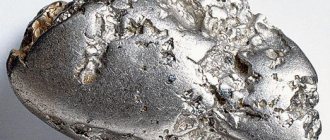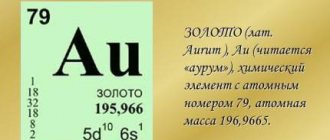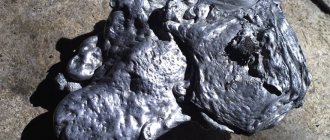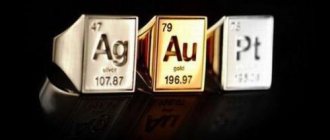Post updated: Oct 8, 2020
Antonio de Ulloa (Spanish surveyor and astronomer) discovered a deposit of platinum during excavations in Peru in 1740; he was interested in the unusual color and hardness of the metal. He was the first to import the future precious metal to Spain for detailed study.
In the 18th century, Spanish scientists discovered the following properties of platinum:
- harder than gold and silver;
- resistant to chemical acids;
- reaction with oxygen produces platinum oxides (reddish brown, brown and black);
- easily alloyed with gold;
- Due to its plasticity, it can be easily forged.
From Spanish platina is a disparaging “little silver” from plata (silver). Indeed, platinum’s color is very similar to silver metal. And the prejudice is due to its low value in Spain - the government banned the import of platina into the country, because jewelers began to mix noble gold with this valueless white metal, and sold the products as gold. All platinum reserves were dumped into the sea under the strictest supervision.
About platinum mining
In the XVIII-XIX centuries. In Europe, platinum, taking into account its special properties, was used only in the creation of chemical equipment and as catalysts. The white metal mined in America at that time was more than enough for such needs.
Platinum mining by "ploughman" in the early 19th century.
On the territory of Russia in 1819, the future precious metal was first discovered in the Urals. Development of the deposit began, and in 1824 platinum mines were discovered in the Nizhny Tagil mining district and in the valley of the Is River (Isovskaya placer). Platinum mining in the Urals has made Russia the world leader in production of this white metal.
Areas of application
Recently, platinum has been widely used:
- In the automotive industry, in particular in the production of catalytic exhaust gas converters. The alloy is used in electronics to create high-precision and optical devices.
- In the petrochemical industry, this metal is necessary to create high-octane gasoline, rubber, the vast majority of monomers and other synthetic materials.
- In medicine, this element is used to create devices and tools. Platinum is necessary in the production of hydrogen peroxide, antibacterial and antiviral drugs. It is also used in the treatment of cancer.
- The space program and nuclear energy cannot operate without platinum. All of the above industries absorb about 60% of the precious metal.
- About 30% of precious metal is consumed in the manufacture of jewelry.
- The remaining 10% serves as a source of financial investment.
Platinum mining methods
The method of mining platinum largely depends on the type of deposit. If the platinum-bearing layers do not lie too deep or on the surface, then the “open” method of its extraction is used, but if the horizon (layer) is located very deep, the “closed” method is used. The technological cycle of platinum mining begins with geological exploration of the proposed deposit.
- With the open method, a small layer of soil is removed, which lies directly on the platinum-containing placer.
- The closed method involves drilling, laying explosives and building deep shafts.
To mine platinum in one way or another, modern technologies are used, and many types of quarry equipment are also used.
How is platinum mined in nature?
Extraction of precious metals using artisanal methods is typical for ordinary people eager to find treasure/treasures. Residents of mountainous regions often search for rich rocks on their own and, using improvised means, try to extract fragments of precious metals (platinum).
One such method is to extract platinum from stone using regular iodine :
First, those on which white veins or inclusions are clearly visible are selected from a pile of stones. Then iodine is drawn into a regular pipette. The reaction of iodine with gold or platinum produces the green color of this substance. If, when the iodine dries, a green coating remains on the surface of the stone, there is the presence of a precious metal.
Platinum is also mined from metal ores. For example, from sulfide copper-nickel or nickel. But during their processing, part of the platinum is lost along with production waste through the enrichment of copper or nickel, so they try not to use this process due to its labor intensity.
How to extract platinum from a catalyst?
You can extract platinum from a car catalyst with your own hands using the “leaching” technology. It is recommended to use an imported device, since gold is often used in the production of domestic cars. “Leaching” involves wetting the catalyst with a solution of high concentration hydrochloric and nitric acids. The process must be carried out at 100 degrees Celsius. After wetting, the device is washed several times, resulting in a mixture containing white metal.
The disadvantage of such an operation is the loss of a certain amount of platinum. It is necessary to take into account the fact that with a long service life of the catalyst, less and less precious deposits remain in it.
Extraction of platinum from radio components
The process of extracting platinum from recycled materials (radio components, electrical installation elements, etc.) at home consists of several stages:
- Dissolution - Selected contacts are brought to a boil in dilute hydrochloric acid to dissolve non-ferrous metals.
- Precipitation - after dissolution, the filtered raw material is immersed in pure hydrochloric acid so that the non-ferrous metal is completely dissolved. Concentrated nitric acid is added dropwise to complete the dissolution cycle. A solution of ammonium chloride is carefully introduced into the resulting mixture of platinum chloride to obtain ammonium hexachloroptatinate.
- Preparation of spongy platinum - the solution is filtered, the resulting yellow salt is again filled with ammonium chloride under vacuum. After such filtration, a precipitate remains; it is dried for several days in the sun or by low heat. The dried sediment is calcined at 800 degrees. The resulting spongy platinum is smelted, poured into a mold and allowed to cool until it becomes an ingot (find out at what temperature platinum melts).
We must not forget that such a process is very dangerous due to the high content of toxic substances in radioelements. Therefore, it is necessary to follow the same safety rules as when working in a laboratory.
How platinum is mined, video
Silver Extraction Methods
The ore contains many impurities that need to be separated from the precious metal. For this, 2 main methods are used.
The most commonly used method is cyanidation. The silver is dissolved in cyanide alkali, and the gangue is removed using filters.
The metal settles to the bottom of the container, is washed with water, passed through filters and melted into ingots. Impurities are removed using sulfuric acid.
Another method is silver amalgamation, which is based on the ability of silver to combine with mercury.
The work is carried out using special equipment, where the ore is driven along the surface of mercury along with water. Metal particles moistened with mercury form a compound, which, after squeezing out the mercury, becomes solid. After the mercury is evaporated, the mixture is filtered and the silver is smelted into ingots.
None of these methods makes it possible to obtain silver of the highest standard, so in the future it is further purified.
How is platinum mined in Russia?
Platinum mining using the example of the richest deposit in Russia - the Konder mine, located in the Khabarovsk Territory in the Far East (the Amur prospecting team):
- The development of the field began in 1984.
- Production area is classified.
- Number of personnel – 1400 people.
- Extraction – platinum group metals.
- Volumes – over 150 tons of precious metals for the entire period of operation of the mine.
- Area of application: automotive industry in Russia, medicine and jewelry production.
A complex technological process is the extraction and production of pure platinum. To get to the platinum sand deposits, workers remove 18-20 meters of waste rock. First they blow it up, then they take it out of the site in dump trucks. The sand containing the precious metal is then washed with a powerful stream of water.
There is only 1 gram of platinum per 1 m3 of sand.
Before mining the rock, miners wash the sand by hand - if grains of white metal are found in the washing tray, then only then do they call in the equipment.
The semi-finished product from the washing machines goes to the processing plant, where pure precious sand is obtained.
Platinum production at this deposit per day is up to 30 kg, and per year - more than 3.5 tons. In order not to reduce such productivity, the management of the enterprise puts into operation high-performance machines and equipment, as well as advanced technologies developed on the basis of leading domestic and foreign centers of the mining industry.
Gold through my fingers
You can find gold grains without buying expensive equipment. Please check the laws before taking any action. If in Australia a gold mining permit costs about $30, then in Russia it is more difficult to obtain such paper. At the same time, for panning gold without permission, having cooperated in a group, you can receive a term of up to 7 years in prison.
To start, consider the tray mining method. Its principle is as follows: by scooping up water with sand and placing it under the current, you allow the light sand to leave the tray, and the golden grains to settle at the bottom, since they are much heavier. These can be barely visible specks of dust, which are then collected by hand. The process is labor-intensive, so it is very important not to make a mistake with the place of extraction, consulting with specialists when choosing a river.
Washing gold using a tray can be done manually both in summer and winter. The tray itself can be purchased, the cost ranges from 500 to 1500 rubles.
To make the work more efficient, it is recommended to first go to the locations and collect soil samples. From a rock with a total weight of about 12.5 kg, if you're lucky, you can get about 2-3 kg of gold sand. Having collected several such samples, you can mark the places on the map, and after examining the samples, you can directly start panning for gold in already explored “golden” places.
Using a gateway.
To separate gold-bearing grains, a sluice for gold washing is required. For on-site sampling, sluices 25-30 cm wide and up to one and a half meters long will be suitable. This is a rectangular “path” along which the river current will drive sand and silt.
Cost may vary depending on:
- Size of the structure;
- Manufacturer;
- New model.
You can make equipment for washing gold yourself. To do this, you need construction parts that can be purchased on the market or in a store. For the frame you will need a metal tray. If you are making a gateway for the first time, limit yourself to a small size so that you can later make a full-fledged model, avoiding beginner mistakes. You will need a T-joint and a wire mesh. A mesh is attached to the sheet of metal, the T-shaped part is attached to the part that will rest in the ground, if desired, this area can be strengthened with an additional sheet of metal. The cost of such a tray is low, about 3-4 thousand. Do-it-yourself sluice making skills will allow you to understand the gold panning process from the inside.
Where is platinum mined in Russia?
Russia ranks second in the world after South Africa in deposits where platinum is mined in large quantities. Not only in the Khabarovsk Territory, but also at large mines in Taimyr, the Primorsky Territory and the Kola Peninsula, deposits of platinum-containing ores are being developed.
Development of platinum deposits in the Urals
About 250 tons of precious metal were mined in the Urals from 1824 to 1922. The Ural deposits are rightfully considered unique to this day, since it was here that nuggets of incredible size were mined. At the Isovskoye deposit, prospectors found the largest (7.86 kg) known nugget of pure platinum, the “Ural Giant,” which is stored in the Diamond Fund of Russia.
At the beginning of the 20th century, the Isovsky and Nizhny Tagil deposits produced about 80% of the total world volume of platinum. But by the middle of the last century, platinum deposits in the Urals were almost completely depleted, and production was reduced to a minimum. Today, only placer residual deposits continue to be developed here.
Platinum deposits on the Kola Peninsula
The primary platinum deposit near Monchegorsk on the Kola Peninsula was discovered by geologists relatively recently. Research into the rock for the presence of platinum has been ongoing here since 2021. If development, which will begin this year (2020), confirms the presence of platinum deposits, this deposit will be considered the richest in Russia.
According to geologists, the 3 km area contains several platinum-bearing strata, on which great hopes are pinned.
What other countries produce platinum?
On an industrial scale, platinum group metals are mined in only four countries. The world's largest platinum deposits are located in South Africa.
Platinum production in the world by country looks like this (see figure):
Platinum mining in China
In the early 2000s, China began to develop platinum deposits. The Jinchuan nickel deposit and Jinbaoshan were considered the largest in China. The content of pure precious metal was only 1.5 grams per ton of developed rock - very little compared to the indicators of the leading countries.
In terms of platinum production, China accounts for 3% of world volumes, sharing them with Colombia and Finland (see figure above), so it can rather be called not a miner, but a consumer of this metal. Today, almost 45% of global consumption of platinum jewelry occurs in China.
Platinum mining in Africa
The world's largest and inexhaustible deposit of platinum group metals is located in the Republic of South Africa (RSA). The gigantic Bushveld complex deposit is estimated to be about 2 billion years old. A third of all platinum in the world is mined here - 140-150 tons annually. The complex consists of three layers of platinum deposits with a length of 1500 km: Merenski, UG2 and Platrif. The deposits of platinum-containing ore in this complex will be enough for more than 10 years of extraction of the purest platinum.
The Bushveld complex was discovered by Hans Merensky (a South African, geologist by training) in 1924.
Another southern African country, Zimbabwe, produces 11 tons per year, which is a good indicator, and puts it among the world leaders in platinum mining. A joint venture between Zimbabwe and Russia, Ruschrome Mining, is developing the Darwendale deposit, where, according to geologists, platinum deposits will allow the extraction of about 30 tons per year.
Platinum mining in Mongolia
The small but resource-rich country of Mongolia, a former republic of the USSR, has large reserves of coal, gold, various metal ores, as well as good deposits of alluvial platinum.
At the moment, negotiations are underway with companies of world leaders in the extraction of minerals, including the discovery and development of deposits of platinum group metals.
Peter Reus (Russian geologist) in 2014, traveling through Mongolia, discovered an accumulation of ore particles in the water of Lake Bayan Nuur, in which, according to the analysis, pure platinum was identified. “In the annals of world platinum mining, there has never been such a rich and such accessible placer,” according to the geologist, the layers of placer platinum lie almost under the entire lake valley and are of great value for the economic development of the country.
Platinum deposits in Kazakhstan
The extraction of platinum group metals in the Republic of Kazakhstan is carried out by isolating precious metal fragments from complex ores during the development of gold deposits.
Platinum deposits in the USA and Canada
An employee marks a rock surface at a platinum mine.
At this mark, the team will drill into the rock. Canada. Up to 5 tons of platinum are mined in Canada per year. The development of deposits of platinum group metals began already in 1908 and still allows Canada to maintain a leading position. Platinum deposits are located in the northwest in the town of Ontario.
USA. Stillwater Mining Co has owned mines in the US state of Montana since 1987. Every year, platinum deposits produce about 6-7 tons of pure precious metal. The ore here is rich in platinum group metals and amounts to 20 grams per ton of rock. Alaska also had fairly rich mines, but they dried up in almost 60 years.
What is the volume of platinum mined in the world annually?
World platinum production is about 170-180 tons annually.
The volumes of platinum mined per year (in tons) for the leading countries can be seen on the graph:
The data is for the last 3 years. The North America indicator includes the United States and Canada. Every year, platinum production decreases. The development of new deposits in Russia and Zimbabwe in 2020 will significantly increase the amount of white precious metal mined.
What are the world's platinum reserves?
Mineral commodity summaries' 2021 Mining, Production and Reserves of Metallic and Non-Metallic Raw Materials 2021 and 2021 Report published estimates of global platinum reserves. They amount to almost 69,000,000 tons in all countries that mine the precious metal.
The world's largest reserves of platinum are in Russia - 3,900,000 tons. Further in descending order in the ranking of leading countries:
- Zimbabwe – 1,200,000 tons
- USA – 900,000 tons
- Canada – 310,000 tons
- South Africa - 63,000 tons.
Companies mining platinum in Russia and the world
Russian mining companies specializing in the extraction and production of platinum are Russian Platinum OJSC (the deposits are located in the Khabarovsk and Krasnoyarsk Territories) and the group, which develops deposits and mines the white metal in Taimyr and the Kola Peninsula. Smaller producers who mine platinum in Russia: Renova, Zolotaya Dolina, Farta.
Platinum-copper ore - Northern Siberia, Norilsk Mining District, Krasnoyarsk.
In South Africa, these companies are Anglo-American Platinum, Lonmin and Sibinanye-Stillwater.
The relevance of independent searches
Every year, millions of people search for deposits and pan for gold. This activity attracts different categories of people, including both beginners and experienced professionals. First of all, gold mining is popular in poor countries, where a large percentage of the population is looking for an opportunity to earn extra money in order to somehow survive. These are African countries, India, New Guinea, the Philippines, Indonesia, and Latin American countries. In countries where the level of income is more favorable, tourists who like the atmosphere of a hike and a gold rush go for metal, as well as experienced geologists or people who devote time to searching for deposits and panning for gold for many years.
Cost of platinum mining
To obtain 25 grams (1 ounce) of pure platinum, an average of 10 tons of ore must be processed. Due to the total costs of deposit development, mining and production of the precious metal, the cost factor was about $1,000 per 1 ounce. This figure changes daily.
For example, on 05/12/2020. the cost of 1 ounce of Pt was $950, and as of May 20, 2020. – 909 dollars.
The high cost of the precious metal is associated with its great practical value (use in many areas), the presence of a small amount in nature and the difficulty of extraction.
Price per 1 gram today
Currently, the demand for platinum is growing steadily, mainly due to the automobile industry. Daily platinum quotes on the exchange are available to our visitors online.
Platinum | RUB | 1 Gram
USDRUB*PL1!*10000000/311034768 chart provided by TradingView
Platinum | USD | 1 Gram
Chart PL1!*10000000/311034768 courtesy of TradingView
Platinum | RUB | 1 oz
USDRUB*PL1 chart! provided by TradingView
Platinum | USD | 1 oz
Schedule PL1! provided by TradingView
You can also take consolidated data from the interactive table.
What are the prospects for platinum mining in the world?
Today, world reserves of platinum are rapidly decreasing, this is due to a reduction in the volume of mined metal. The developed deposits have already spent their potential, while new deposits of platinum-containing ores are still being explored and developed.
According to forecasts, platinum production in South Africa, Zimbabwe and Russia - leading countries in the production of the white metal - will grow due to new, already explored deposits.
In South Africa, the full potential of the Bushveld mines has not yet been fully realized, and in Russia they have high hopes for platinum-bearing strata on the Kola Peninsula.
The decline in global platinum production over the past few years will in the near future be replaced by a huge increase in this mineral.
Platinum mining and environmental impact
The development of deposits and the extraction of platinum, like other metals, leads to a significant deterioration in the ecology of the work site: disruption of the landscape of vast areas, deterioration in the quality of water and forests, which in turn leads to a reduction in the population of flora and fauna.
The technological process of extracting ores from rock uses a large volume of water, and after washing, tons of wastewater containing large amounts of metal fragments are discharged into water bodies without proper filtration.
And since most of the mines are located in the upper reaches of rivers, they become sources of pollution in areas located downstream. Muddy and often poisonous streams are carried for hundreds of kilometers. At the same time, environmental pollution continues for many years after the cessation of production due to waste dumps, which are also washed away by the river over time. For example, the prospectors of the Conder mine have already worked out the main area and are moving downstream of the river, leaving behind huge “lunar landscapes” of bare earth, clearly visible even from space.
Properties
The popularity of silver and its many uses is explained by the physical and chemical properties of the element.
Physical properties
The pure element is heavy, its density is 10.5 g/cm³. The metal has a silver-white color and the following physical properties:
- softness;
- extraordinary plasticity - during processing the material easily changes shape;
- thermal conductivity 429 W/(m*K) - the highest among metals;
- highest electrical conductivity (at room temperature) among metals;
- relative refractoriness—melting point 962 °C;
- reflectivity - the property is used to make mirrors;
- no susceptibility to corrosion.
Chemical properties
In the periodic table of Mendeleev, silver has atomic number 47. It belongs to group 11 (copper subgroup). The chemical properties of the element are as follows:
- lack of reaction with other substances (natural conditions);
- opposition to aqua regia;
- no exposure to oxygen, silicon;
- dissolution in mercury to form an amalgam (liquid alloy) - this property is used in metal processing;
- dissolution in nitric, hydrochloric (if oxygen is present), hot concentrated sulfuric acid;
- formation of sulfide when heated with sulfur;
- with ultraviolet irradiation, oxidation with ozone and oxygen plasma, thin films are formed;
- sensitivity to sulfur;
- tarnishing (darkening) over time - the cause is a reaction with traces of hydrogen sulfide in the air, a sulfide deposit with a pinkish film is formed;
- insolubility of silver salts in water with the exception of nitrate, fluoride, perchlorate.










